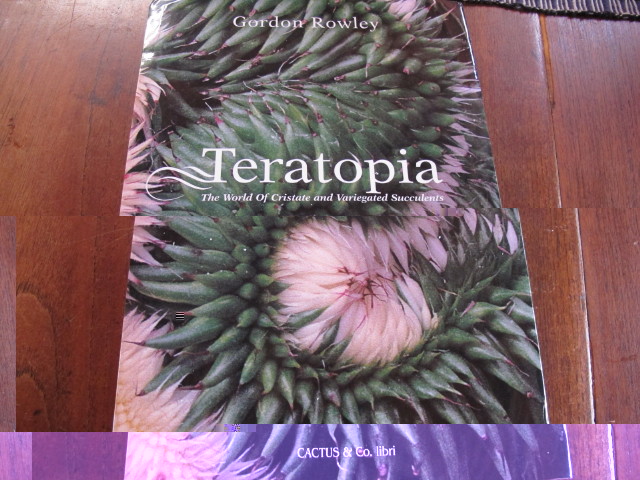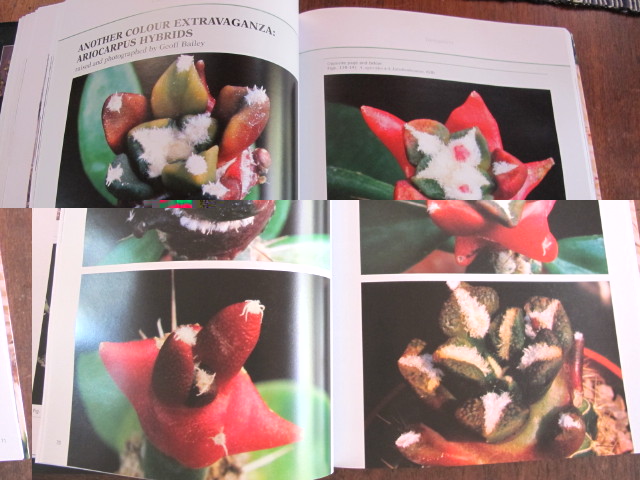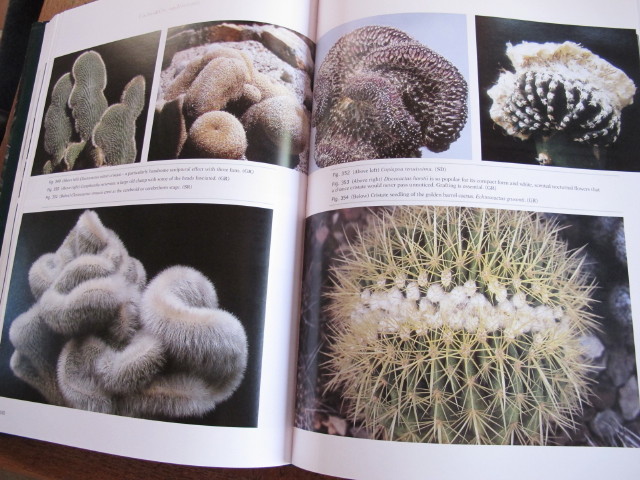Página 1 de 1
Teratopia-The World of Cristate and Variegated Succulents
Publicado: Mar Nov 20, 2012 3:53 am
por Lorette
Teratopia -The World of Cristate and Variegated Succulents -
Autor: Gordon Rowley
287 páginas
Idioma :Inglés

- IMG_4908.jpg (122.58 KiB) Visto 8400 veces
Contiene preciosas fotos de cristaciones, monstruosidades, variegaciones, quimeras, formas espiraladas etc. Aún cuando estos fenómenos no tienen una explicación científica muy precisa, el autor describe con claridad como ocurren y se manifiestan tanto en cultivo como en la naturaleza.
Algunas fotos del interior del libro:

- IMG_4909.jpg (71.14 KiB) Visto 8400 veces

- IMG_4910.jpg (101.16 KiB) Visto 8400 veces

- IMG_4911.jpg (123.28 KiB) Visto 8400 veces

- IMG_4912.jpg (105.93 KiB) Visto 8400 veces
Saludos
Re: Teratopia-The World of Cristate and Variegated Succulent
Publicado: Mar Nov 20, 2012 11:44 am
por Amante De Los Cactus
Le echaré un vistazo.
Saludos y gracias Lorette.
Re: Teratopia-The World of Cristate and Variegated Succulent
Publicado: Mar Nov 20, 2012 1:48 pm
por lorquino
Que buena pinta tiene el libro, nos puedes poner el I.S.B.N., el resto de datos ya están en la 1ª foto, gracias.
Re: Teratopia-The World of Cristate and Variegated Succulent
Publicado: Mar Nov 20, 2012 2:17 pm
por Lorette
Hola Lorquino
Aquí están los datos que faltan
 Publisher: Cactus & Co.
Publisher: Cactus & Co.
Date: 2006
ISBN 10: 8895018087
ISBN 13: 9788895018089
Language: English
Weight: 3 lbs 13.2 ounces
Saludos
Re: Teratopia-The World of Cristate and Variegated Succulent
Publicado: Mar Nov 20, 2012 2:43 pm
por vbueno
Es un libro visual por excelencia.
Os dejo la introducción
"Our most modem science is not yet able to dispense with mythical personages. A great
multitude of phenornena do we attribute to Nature. Nature, everi with us, is said to take
all kinds of courses and rnake all sorts of [reaks. We refer to that same old myth a thousand
facts and conditions which. we are still unable to explain. "
-E.L. GREEN "Landmarks of a Botanical History" 11: 997,1983.
/
Teratology is the word coined in 1832 by Isidore Geoffroy Saint-Hilaire for the scientific study of
monsters. Initially, animals attracted more attention than plants, and all manner of myths and legends
grew up. A woman unfortunate enough to give birth to a malforrned child was accused with
having consort with the devil, and the association of disease and abnormality arose early. The occurrence
of freaks and outlandish monsters has always exerted a fascination, but never more so than
in the sixteenth century when it became a cult and part of the general curiosity into the divine plan
of life. Collections were built up called cabinets of curiosities, the larger and more extravagant the
better. Wealthy dilettantes amassed museums of giant bones, petrifactíons, stuffed two-headed or deformed
animals, supposed dragons and anything exotic or macabre. Among them were plant oddities:
witches brooms, mandrake roots and dried fasciations. Cheating was permitted to create
chimeras by stitching together bits of different animals. This is the dark side of teratology: today we
are less interested in the pathology and rarity value than the light such anomalies can throw on genetics
and evolution.
In the Plant Kingdom, teratology developed as a serious study in the nineteenth century, conveniently
packaged in English in two publications of the Ray Society in London. "Vegetable
Teratology" by M.T. Masters appeared in one volume in 1869, and "Principles of Plant Teratology" by
W.C. Wordsell followed in two volumes 1915 - 1916. Both attempt a classification of plant aberrations,
and both invent or adapt suitable terminology. Both attempt at great length to "explain" how
freaks originate, Masters cautiously, Wordsell incautiously with anachronistic views on heredity
and ontogeny. In the post-Darwinian era monsters are seen as the product of rnutation, invariably
at a disadvantage as compared to the norm, so that they are eliminated in the wild. Hugo De Vries,
the celebrated botanist in the Netherlands at the end of the century, selected monstrosities of the
evening primrose (Oenothera) for breeding experiments in favour of his mutation theory.
Unfortunately what he didn't know was that the greatest monstrosity in Oenothera lies in its chromosornes,
united in rings and inherited as such, which upset his breeding ratios and led to the sudden
appearance of new major deviants in the progenies. "Monsters", renamed "Macro-rnutations"
became involved in the conflict among evolutionists on whether evolution progressed by small
stages or by abrupt leaps.
Human attitudes to them vary, as does the definition of what we call monstrose. We are repelled at
the sight of deformed animals, yet cherish highly bred dogs, birds and fish, unlike anything in nature
and wholly dependent upon us for survival. The most esteemed roses of our garden are monsters, bred
from four or more wild species and often almost or completely sterile. Fortunately the aesthetics of
teratology need not concern us here, although the issue of how they come about has to be faced, if
only because it is the first question any observer asks: "How did my plant come to do this?" Perhaps
the best answer to that would be: "I don't know, I wasn't there when it happenedl" The subject will be
addressed more formally in the chapter on fasciation, along with the equally tantalising "how can you
make plants go cristate?"
Of the numerous types of teratological growth in plants, t\,VOare of majar interest here, and both
are exceptionally well represented in the plants we call succulent. The first is fasciation, a fairly welldefined
phenomenon that turns a normally cylindrical stem into a wedge, fan or crest, that later may
become convoluted into a brain-like mass (see Figs. 4-8). This involves a change in symmetry from
radial to bilateral: the stem ceases to grow in length, but instead grows sideways in one planeo This
may lead to a specimen very unlike the normal parent, with smaller leaves, more ribs, altered branching
and suppression of flowers. Some eristate plants remain tiny gems; others expand well beyond
the proportions of unfasciated plants: a Ferocactus over 1 m wide (Snyder & Weber 1966), or the
saguaro, Carnegiea, over 4 m from tip to tipo
Second is variegation, the partial absence of chlorophyll, the green pigment contained in
lens-shaped plastids within the cells and essential for photosynthesis to take place. Its localised
absence leads to leaves or stems having stripes or blotches of yellow or white (or orange or purple
if other pigments are present). Total absence gives an albino plant, that can survive only parasitically
as a graft on a green stock. Variegation is an essentially different phenomenon from fasciation,
involving the side-by-side development of two celllineages, one producing normal green
chlorophyll, the other non-green. We call such a plant combining two or more genetically distinct
tissues a chimera after the legendary monster made up of bits of different animals joined
together.
Observant plantsmen often encounter teratologies
among their charges, when nature's notquite-
infallible programming seems to slip a cog:
oddly shaped leaves, freakish flowers, twinned
fruits and so on. Most are "one-off" events, perhaps
resulting from some sort of injury, and unlikely
to excite the collecting urge. Double flowers,
with stamens and sometimes carpels replaced
by petal-like organs, are one exception,
but outside the present survey. Very few succu-
1ents qualify.
Monstrosities in the narrow sense are plants
resembling fasciations but with even greater loss
of symmetry, and lacking a single dominant, linear
apex (Fig. 14). The adjective monstrose is
preferable to monstrous which implies malignancy.
Proliferation is a different phenomenon
in which every bud that can grow does, giving a
cauliflower-like appearance to the plant (Fig. 15). Other aberrations include spiral torsion, spinelessness
(Fig. 16) and follar follies: appendages emerging from leaves.
Teratology seems to be a no-rnan's land for research, combining as it does aspects of morphology,
genetics and pathology but shunned by investigators of all three disciplines. Hence there is a dearth
of general literature. Among succulents, the one and only book is "The Enigma of the Origin of
Monstrosity and Cristation in Succulent Plants" by J.J.Y.Wolthuys that carne out in Dutch and English
in 1938 and was reprinted in a revised form in 1948. This is an admirable introduction to the subject
for growers, but as the title suggests gives so much prominence to the unanswerable question that it
seems to have discouraged future inquiries. However, the periodicals on gardening and succulents
teem with isolated illustrations and notes on freaks and oddities, and a hunt down the highways and
byways of scientific journals brings to light enough evidence to show that, if we are still uncertain
about the initial stages, the early development and elaboration from aberrant meristems are well understood
and provide an appropriate introduction to their subsequent expansion and diversification.
As regards terminology, despite a wealth of technical terrns, mostly rare or long forgotten, to cover
different types of aberration, 1 have yet to see teratophyte for any teratological plant, which seems
a useful addition to the language, along with teratophile and teratophobe for the person who respectively
loves or hates such oddities.
This book presents a picture gallery of succulent teratophytes selected for their beauty, rarity or
desirability for collections. There can be no cornpleteness, no systematic catalogue or identification
key: novelties are arising all the time, and when least expected. Formal descriptions, on the
lines of those in floras and monographs, would serve little purpose. More to the point are details
of availabílity, propagation and cultural treatment. Overall the pictures give a cross-section of what
is to be seen in the wild and in captivity, and as such they may serve to stimulate new converts to
take up a challenging, unpredictable but hugely rewarding study.
Re: Teratopia-The World of Cristate and Variegated Succulent
Publicado: Mar Nov 20, 2012 8:10 pm
por tejure
Se ve muy bien , pero el ingles no es para principiantes,¿entonces la unica manera de conseguir varios es plantar muchos y esperar?
Re: Teratopia-The World of Cristate and Variegated Succulent
Publicado: Mar Nov 20, 2012 9:06 pm
por vbueno
Rowley lleva en ello desde jovencito. Y ya desde hace muchos años ha experimentado métodos de producción y reproducción de cristats, monstruosas...
Algunos clones de los cactus allí fotografiados los tenemos en nuestras colecciones, reproducidos por esquejes injertados o no.
Saludos
Vicent
P.D. En ACYS conseguimos el libro escribiendo a la revista italina Cactus & Co. Tardaron un poco en hacerlo, pero al final lo enviaron.
Vale la penas por las fotos
Re: Teratopia-The World of Cristate and Variegated Succulent
Publicado: Mar Nov 20, 2012 10:27 pm
por tejure
Seguro que es muy dificil, pero lla parodia buinigini cristata que en un post me dijo yamal que era muy rara la encontre en un vivero y estaban la normal y la cristada igual de precio y habia muchas de ambas.¿entonces habran conseguido hacerlo no? o sera mejor ver el libro.Y esta muy bien eso de ver la planta de donde viene la tuya-Un saludo
Re: Teratopia-The World of Cristate and Variegated Succulent
Publicado: Mar Nov 20, 2012 10:54 pm
por Yamal
Que guapada de libro.
Re: Teratopia-The World of Cristate and Variegated Succulent
Publicado: Mié Nov 21, 2012 1:12 pm
por vbueno
Hola, Tejure.Cualquier cactus, como por ejemoplo la parodia bunigini puede ser raro y luego dejar de serlo. Pasa también con las personas ¿no, Yamal?.
Bromas aparte, he visto en Catadau decenas de cristatas de una misma especie en una mesa de cultivo, sobre todo mammillarias, parodias y echinopsis (que por otra parte son de lo que más siembran).
Evidentemente, el factor estresor o la predisposición genética (o la combinación de ambos) que desencadenó la cristación lo hizo en más de un especimen. Otra cosa es reproducir esos factores.
Un ejemplo de cristata rara es la de Strombocactus disciformis. Se obtuvo una en el Charco del Ingenio de México, se reprodujo y difundió. Las vendían a 1 dólar. Aquí llegó a Cactus art y las reprodujo y vendió muchísimo más caras.
http://www.cactus-art.biz/schede/STROMB ... tomica.htm
(acabaron transformándose en formas politómicas, para mi muy interesantes también.
Normalmente, las formas crestadas crecen más rápido que las normales y sus hijuelos prenden muy bien.
Saludos
Vicent
http://www.cactus-art.biz/schede/STROMB ... tomica.htm
http://www.cactuscenterclub.com/phpBB2/ ... .php?t=287
Re: Teratopia-The World of Cristate and Variegated Succulent
Publicado: Mié Nov 21, 2012 3:39 pm
por tejure
Muchas gracias por la explicacion, ahora queda todo bastante claro.Habra que ponerse a intentar saber porque se producen esas mutaciones, el que lo consiguiera tendria el mismo exito que descubrir un crecepelo.Pero lo habran intentado tantas veces y de tantas maneras que sera tan complicado como conseguir una rosa azul, y luego que sea mas bonita que el original , ya que la cristacion del aeonium arboreum no supera al normal.Si me sale alguna cristada la compartire con vosotros,( bueno tengo el aeonium arboreum disponible). Un saludo
Re: Teratopia-The World of Cristate and Variegated Succulent
Publicado: Mié Nov 21, 2012 7:08 pm
por vbueno
El prólogo que dice cosas muy interesantes como que la mayoría de las rosas de nuestros rosales son formas monstruosas de flor.
El que quiera entretenerse con las andanzas de Rowley desde jovenzuelo buscando producir cristatas, monstruosas y demás, puede mirar en internet.
Pero seamos realistas, somos jardineros, no ingenieros transgénicos y de estos últimos no me fío un pelo.
La naturaleza produce mutaciones de toda clase, algunas de ellas bellísimas, como por ejemplo la M. theresae de flor blanca. Se produjo un ejemplar y, a partir de él todo el mundillo cactusero puede tener un clon de ese excepcional ejemplar.
Nosotros podemos hacer híbridos, lo cual tampoco está mal.
Saludos
Vicent
Re: Teratopia-The World of Cristate and Variegated Succulent
Publicado: Mié Nov 21, 2012 8:08 pm
por tejure
Eres una enciclopedia,gracias nuevamente por compartir lo que sabes y muchos desconocemos
Re: Teratopia-The World of Cristate and Variegated Succulent
Publicado: Jue Nov 22, 2012 12:24 am
por lorquino
Muchas gracias.
Re: Teratopia-The World of Cristate and Variegated Succulent
Publicado: Jue Nov 22, 2012 8:43 am
por vbueno
Gracias a vosotros.
Las monstruosidades y cristaciones también se dan en la flores de cactus, como el Astrophytum caput medusae y otros que pone el malvado Dr. Weed:
http://www.infojardin.com/foro/showthre ... light=Weed
Saludos
Vicent